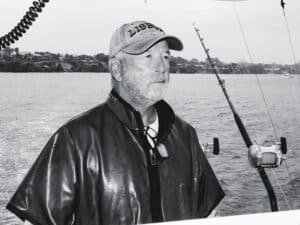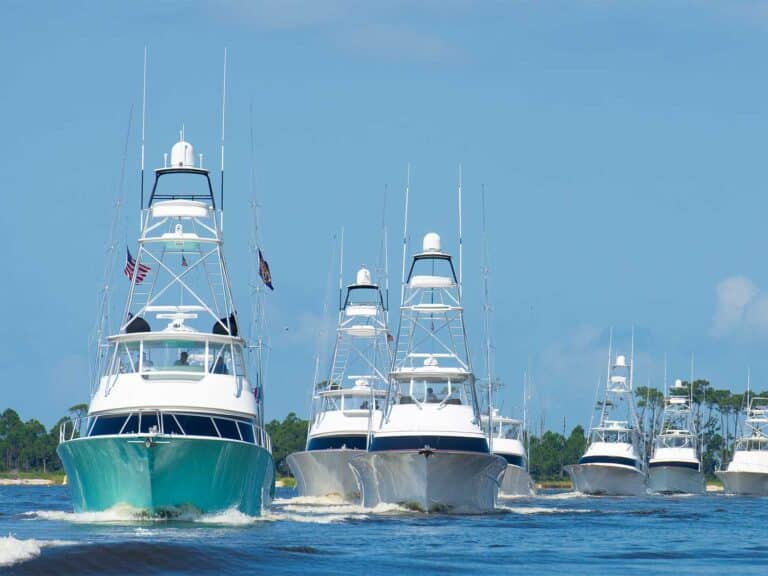See 1-25 of the Marlin 100 here / See 26-50 of the Marlin 100 here / See 51-75 of the Marlin 100 here
76. Dinner on the Dock
Some of the best cooks I’ve ever met have been mates on sport-fishing boats. Mealtime becomes extra special when you spend a lot of time far from home, and if no one on board knows how to cook, things can get ugly fast – especially if the fishing’s slow. Eating Ramen noodles 10 days in a row just doesn’t motivate like a home-cooked meal. So if a prospective mate can’t cook, he’d better learn; otherwise, he’s always one step away from being let go.
With that said, dinnertime on the dock is one of the best parts of the day. Owners and crews start making plans on the radio during the ride in, telling each other what they’ve got in the freezer and what they can bring to the table for the evening meal. If the weather is nice and the bugs are down, a few lawn chairs on the dock and couple of rum drinks makes it all good ? just another day in paradise.

77. Boat T-Shirts
While there are few ways a crew can exercise their creative side, the boat T-shirt allows them to let it all hang out – in some cases, literally. Some of the hottest girls in the world appear on boat T-shirts, most riding high on the back of a jumping blue marlin sans bikini top. Others play up the boat’s name or favorite place to fish with a witty headline or a simple declaration of who they are and what they plan to do.
Originally given out by charter boats to act as long-lasting, wearable advertisement, nowadays just about anyone with a traveling program gets some shirts made up for crew “uniforms” or to give away to guests.
And if your budget doesn’t have room for a globetrotting trip to collect boat and fishing T-shirts from around the world, you can join the Blue Water Shirt Club and have a different one sent to your house each month! For more information, visit www.bluewatershirtclub.com.
**

- Teak**
Although a teak deck and transom translates into a lot of maintenance, nothing looks, sounds or feels like the warm, resounding thump you get when you hop on board a boat with a teak-wood deck. A tropical hardwood native to Southeast Asia, teak holds a large amount of natural oils that make it the perfect wood for exposed areas, and its fine grain provides good footing even when wet. It’s just a bonus that it looks so good.
79. Long-Sleeved T-Shirt
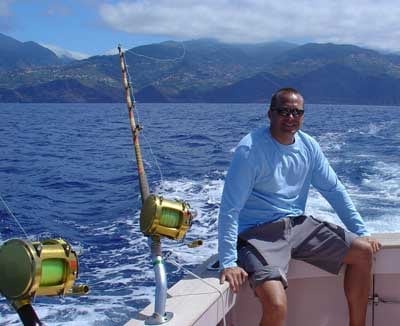
Have you ever seen an Arab roaming around in the desert wearing a wife-beater tank top and a pair of board shorts? Of course you haven’t, because if you spend any time at all in the blazing sun, you’ll soon realize it’s a lot cooler to cover up and sweat a bit than to leave your skin exposed to the sun’s rays. Wearing a light-colored (white is best) long-sleeved T-shirt wicks the sweat off your body, and the resulting evaporation actually helps cool your skin. To complete your offshore outfit, cover up with a wide-brimmed hat, buff and plenty of sunscreen to keep your face from looking like the cracked, sun-bleached dashboard of a ’72 Datsun.
**
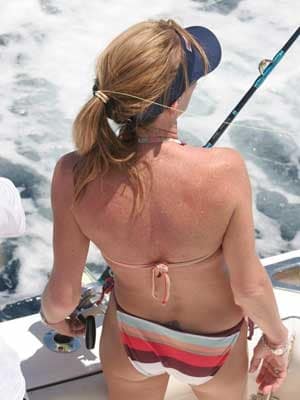
- Girls Fishing**
Nothing’s quite as sexy as a woman who’s not afraid to pop the eyeballs out of a ballyhoo. Let’s face it fellows – fishing is not for guys only. Ladies keep us in check on the water and make better students than men because they actually listen and always want to prove they can hang with the boys. A lot of guys like to talk smack, but there are plenty of women out there who kick butt in the cockpit. Don’t be afraid to take the wife out on your next fishing trip – a family that fishes together stays together.
81. Rolex Watch
The days of navigating by watch and compass are long gone, but boaters still harbor a strong affinity for quality timepieces. Few watches can stand up to the rough saltwater environment better than the Rolex Submariner. This classic watch has graced the wrists of some of the world’s best anglers and sailors for one reason – its dependability. You can find these watches for sale all over the globe, but nothing’s quite as sweet as winning a Rolex in a billfish tournament. It’s a family heirloom worthy of passing down to a future fisherman.
**
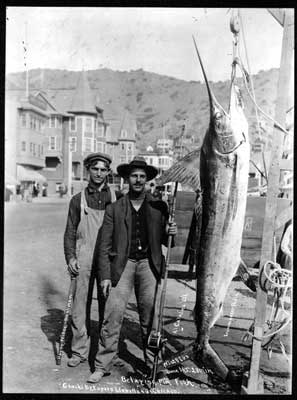
- Tuna Club**
Founded in 1898 on Catalina Island off the coast of Southern California, the Tuna Club links present-day anglers with yesterday’s traditions. The clubhouse, built in 1916, houses a priceless collection of fishing artifacts and is registered as a historical landmark.
Club rules say all catches must come on linen or Dacron line to be recognized, just like Harry Wylie’s striped marlin caught in 1903 (see photo below) – the first billfish ever taken on rod and reel. The long list of Tuna Club members includes presidents, heads of state, actors and notable outdoorsmen such as Winston Churchill, Theodore Roosevelt, Cecil B. DeMille and Zane Grey. The Tuna Club puts on annual club tournaments each year but also plays an active role in conservation and marine research. Going into its 110th year, the Tuna Club stands out as the oldest angling club in existence. To learn more, visit www.tunaclub.com.
83. Custom Hawaii Lures
Kona, Hawaii, stands out as the birthplace of lure making. It all started when Capt. Henry Chee let some resin harden in a glass jar and shaped it into the slanted-head lure now referred to as a Kona head. Since those early days, a long list of lure makers has hailed from the Big Island, and their beautiful wares have caught fish all over the world. It didn’t take long for lure makers around the globe to pick up on the innovative stylings coming out of Hawaii, such as using shell inserts and various reflective materials to give lure heads more flare.
Marlin Parker and Joe Yee are some of the better-known lure makers turning out flashy ones, but they’re not alone. Bomboy Llanes, Steve Coggin, Eric Rusnak, Sonny Arita and several other talented lure makers in Hawaii are keeping the tradition alive and creating some real gems that will catch a fisherman’s eye just as quickly as a blue marlin’s.
84. Electrical Suites
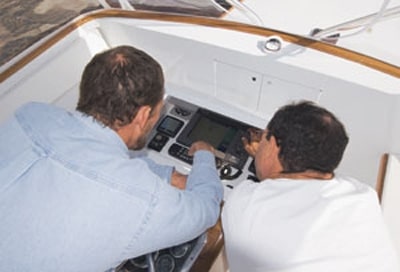
The strides in marine electronics over the last 20 years opened the sport of big-game fishing to the masses. However, as technology continues to come of age, more components can “talk” to each other, allowing captains to set up ultra-sleek electronic suites with multifunction monitors taking up less space on the console. Over-head electronic boxes don’t show up on many bridges these days, leaving more room for teaser reels. Most builders install the electronic suite in a pod that uses hydraulic arms to slide up and down so your treasured monitors will be out of sight and out of mind when not in use. But even the most high-tech gizmo doesn’t do you much good if you don’t know how to use it. Just about any yahoo can find the edge with a GPS and compass, but that doesn’t mean they can fish it. So free up your schedule and study that owner’s manual (the units might be getting smaller, but the manuals keep getting fatter!). Knowing how to use that fancy commercial sounder and that ultra-trick radar translates to more fish in the spread.
85. The World Cup
Tex Schramm, the legendary general manager of the Dallas Cowboys, also had a penchant for blue marlin. While out fishing with his buddy Jim Hardie, the Miami-based outdoor columnist, the pair came up with the idea to create a “super bowl” of blue marlin fishing: a one-day, worldwide, winner-take-all blue marlin tournament. They chose to schedule the event for the Fourth of July, and whoever caught the biggest blue marlin in the world that day would win it all. The World Cup Blue Marlin Tournament continues to thrive to this day.
Boats compete in various time zones around the world, but Bermuda has been the hot location as of late, winning four out of the last five events. Other hot spots include Kona, Hawaii, which won it five times, and Madeira, with three wins. The 24th running of the World Cup will kick off July 4, and tournament director Mike Leech says boats from the west coast of Africa to the South Pacific will compete for the big payday. For more info, visit www.bluemarlinworldcup.com.
**
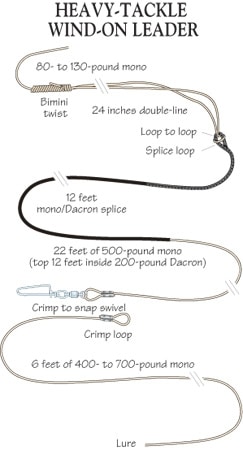
- Wind-On Leaders**
Back in the days before wind-on leaders, once the swivel hit the rod tip, the wireman still had 30 feet of leader material to handle before he could get a tag or gaff into the fish. While this is a lot of fun for an experienced wireman, neophytes have a hard time properly and safely managing all of that heavy leader material. One errant loop can cause serious injury or even result in the wireman getting pulled from the boat.
Invented during the late 1990s (their first mention was in the September 1998 issue), wind-on leaders consist of a long, wind-on section of leader that’s attached to the main line using a loop-to-loop connection or Dacron splice. This section terminates to a snap swivel, allowing you to use 5-foot sections of heavy mono on your lure. This configuration allows the angler to safely wind the fish right up to the boat for a tag-and-release with little or no assistance from a wireman.
87. Kids Fishing
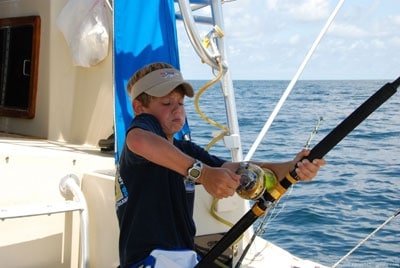
That barracuda flipping behind the boat may just be a bait-stealing nuisance to the experienced angler, but any snarly-toothed fish energizes a child like a bolt of lightening. Watching a young boy or girl fight a fish with all their might and seeing the sense of accomplishment that overcomes them upon bringing it to the boat is truly priceless. Fishing with kids reminds us how lucky we are to be out on the water chasing these fantastic creatures. Studies show that today’s children favor video games over the outdoors, and it’s a shame. Take kids fishing on your next trip; introduce them to the wonders of the ocean and let their good vibes wear off on you. The future of our sport depends on it.
88. The Men of the Outer Banks
The little chain of sandbar islands that make up North Carolina’s Outer Banks hold a special place in the lore and legend of big-game fishing. After humble inshore beginnings, fishing for sport eventually replaced commercial fishing, one of the area’s largest industries. Soon the species caught changed from inshore fish like seatrout, bluefish, striped bass (known locally as rockfish), red drum and sea bass to offshore predators like wahoo, dolphin, tuna, white marlin and, the king of them all, blue marlin.
Skippers soon converted wooden-planked commercial boats into sleek, fast, blue-water speedsters with gleaming, yacht-like finishes. The style and flare of Carolina boats became legendary in the process.
But the men who fished there leap to the front of my mind when I think about the Outer Banks. Saying that a Carolina man is “salty” is a badge or title more than a mere physical description. These seagoing ambassadors have trolled the world’s fishing grounds, leaving evidence of their good character and professionalism along the way. The surnames Perry, Baum, Spencer, Davis, Smith, Tillett, Harris, Holton, Guthrie and too many more to name will forever extend this area’s legacy to the four corners of the fishing world. These men are what I associate with the Outer Banks. – Peter Wright
89. Faster, Bigger Boats

With more and more anglers searching farther a field for more consistent billfish action, the last 10 years saw sport-fishing boats reach unheard-of sizes and speeds. During the 1990s, a 55-footer was usually the biggest boat at the dock, and hardly anybody cruised at 35 knots. Nowadays, 70-footers hardly turn a head anymore and these big sport-fishers cruise close to 40 knots – with some hitting well over 40 at wide-open throttle.
With the use of super-lightweight composites, combined with extremely efficient common-rail diesel engines, there’s no telling what builders will trot out for us to drool over next.
90. Venezuela
As we trolled the northern side of the La Guaira Bank on the lovely 48-foot Garlington Courtesan, Capt. Dave Noling and I tried to dodge the barrage of giant red rubber bands fired by Alberto Sanchez from the cockpit below. As I lifted my head to take a peek at the spread, a flash of brilliant blue caught the corner of my right eye. Before I could speak, Noling was shouting, “Here they come!” “They” was right – a swarm of white marlin, at least 20, descended into the trough onto our baits and teasers. In a matter of seconds every bait and teaser took a pummeling from one or two lit-up whites. We ended up catching three of them, but it wasn’t the catching that made our day, it was seeing an entire school of white marlin thrash the baits. Here’s the kicker: We went on to catch five whites and five blues that day.
Venezuela beats the entire world in two areas, sheer numbers and variety. From late September through November the white marlin bite can be nothing short of spectacular, and since sails and blues also linger in the area during this time, the possibility of a grand slam is more the rule than the exception. From February through June, blue marlin move through in such numbers that catching four or five a day becomes commonplace. I actually caught 19 blue marlin, six sails and a 160-pound yellowfin tuna on three-day trip in April with my good friend Capt. Jimmy Grant. Even with political problems facing the country these days, Venezuela still tops my list of fishing destinations hands-down. To get your shots, contact Grant at [email protected], or call 011-584-143-244544. To fish with Capt. Bubba Carter, contact Joan Vernon at 888-365-9601. – Dave Ferrell
91. Backing Down!
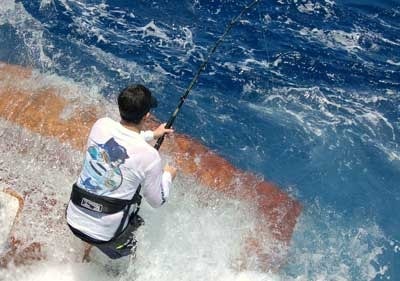
We all know that boats move faster going forward than they do going backward, but at the end of the game, charging back to tag a fish for the release or to gaff it for a big tournament win remains an exhilarating part of the sport. With water cascading into the cockpit, alarm bells going off and mates stretching out as far as they can to get a hand on the leader or a good tag shot, backing down manages to thrill even the saltiest captain right down to his skivvies. In the immortal words of Capt. Hayden Bell on Release out of Cairns, Australia, “It gives me a horn!”
92. Split-Tail Mullet
A hardy split-tailed mullet, either rigged as teaser for a dredge or armed with hook, takes a beating and keeps on kicking. A skilled mate like Hatterascal’s Capt. Dave Fields can rig 150 mullet in a single morning and have each one swimming better than a live bait.
Although Florida fishermen were deboning and wedging (taking a triangular section out the bait’s skull to flatten it out) mullet, Charlie “Splittail” Hayden was the first guy to take it a step further and split the bait right down through the tail. The result was a revolutionary bait so popular with fishermen that it launched Hayden’s business, Splittail’s Trolling Baits out of Riviera Beach, Florida, in 1974.
93. Bait Masters
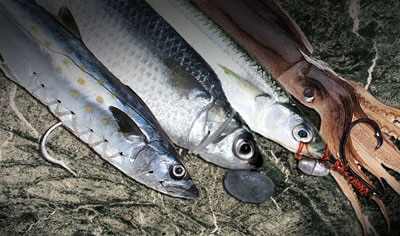
While most everyone likes to obtain fresh baits and prepare them themselves, it’s good to know you have company like Baitmasters as a backup or even a primary bait supplier. This Miami-based company owned and operated by Mark Pumo ships high-quality frozen baits, either rigged or unrigged, to boats fishing all over the circuit. A peek at their website shows that his baits have won some of the most prestigious tournaments in the world. For more information, visit www.baitmasters.com.
94. Foreign Foods
If you are one of those people who eats at McDonalds while traveling overseas, you can skip this one. We’ve got no time for or patience with your unadventurous palate! For myself, there’s nothing more satisfying than settling down to a steaming plate of street food in a place I’ve never been before. Sharing meal in the places where the local folks eat is one of the best ways immerse yourself in a country’s culture, which is almost as much fun as the fishing. The next time the driver is whisking you from the airport to your hotel, have him take you to a place where he likes to eat – you’ll rarely be disappointed. – Dave Ferrell
95. GPS
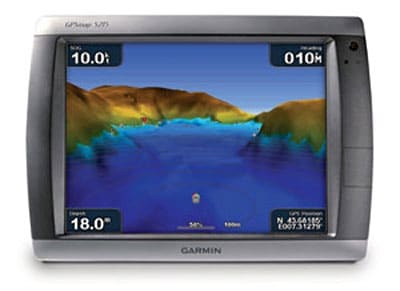
Oftentimes, you’ll overhear some nimrod complain about the cost of the space program and how “it never did anything to help me out.” Well, if that fellow ever used a Global Positioning System, then he was dead wrong. Originally developed by the Department of Defense during the early ’70s, GPS uses a series of orbiting satellites and an end-user receiver to pinpoint your position on the planet to within three feet. Available to the general public since 1982, GPS opened up and simplified the mystical world of open-ocean navigation to the masses, spurring boat sales and allowing less-experienced captains to travel long distances with amazing accuracy.
96. Bait Cooler
No matter how much you spend on your sport-fisher and no matter how many bait freezers and prep stations you add on, be prepared to share your cockpit with a 72-quart bait cooler. Until a boat manufacturer makes a bait storage unit that sits neatly and conveniently under the chair that can be repositioned at will, the well-stocked bait cooler will continue to reign supreme. And don’t go lifting another man’s cooler lid without asking first.
97. Capt. Skip Smith
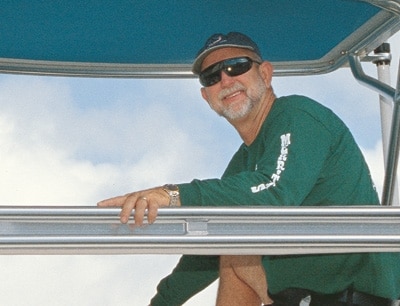
The number of accomplishments that Capt. Skip Smith crammed into his 30-year career at the helm definitely qualifies him for living-legend status. The architect of the bait-and-switch, Smith guided Deborah and Jerry Dunaway to over 80 world records during his stint on their world-famous Madam and Hooker mothership operation. And while he made his name as a sport-fishing captain, not a lot of people know that during the 1970s Smith pioneered many of the techniques that commercial fishermen still use today.
The one thing that boosted Smith’s career the most was probably when the IGFA opened light-tackle categories in the billfish division in 1982. While trying to set some of those records with the Dunaways, he developed the bait-and-switch to match the tackle to the fish raised in the spread. He also scored the first 40-to-one catch of its time, Marge Love’s 162-pound blue caught on 4-pound and the first-ever super grand slam for Janice Ebarb in May of 1981.
Smith retired from the helm and eventually partnered with Roy Merritt to form Smith-Merritt Insurance in Fort Lauderdale in 1995 when, according to Smith, his “sex trophy arrived – the birth of my son.” What’s so great about that is you can call up Smith-Merritt at any time (954-784-1807) under the guise of getting some insurance and pick Smith’s brain with a marlin question.
98. Florida Swordfishin’
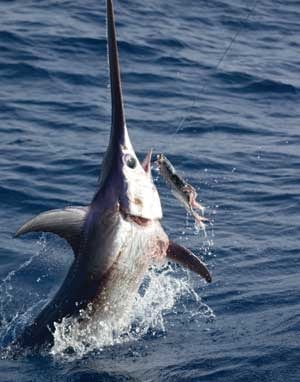
Recreational swordfishing thrived off the Florida coastline in the 1970s before the longliners moved in and wiped out the fishery. The National Marine Fisheries Service, sensing a complete collapse of the species, stepped up to the plate in 2001 and prohibited longliners from fishing in the spawning areas from the Florida Straits north to the Charleston Bump. This move helped swordfish recover, and recreational anglers once again began fishing the deep with great success.
Venture offshore on a calm, moonlit night off south Florida and you’ll see sport-fishers dotting the horizon; however, some crews catch them during the day as well using deep-drop techniques. But we’re not out of the woods. In early 2008, NMFS permitted two longliners back into the closed zone to study the effectiveness of bycatch reduction measures. Many fear this move opens the door to more commercial swordfishing. Only time will tell, but for now, take a trip to Miami and do battle with the gladiator of the sea, the broadbill swordfish.
99. Mid-Atlantic $500,000
The Mid-Atlantic $500,000 is actually misnamed; from its inception in 1991, the tournament has given out more than $1,000,000 in prizes each year. It even bills itself as the first tournament with a legitimate $1 million payout. Tournament director Bob Glover says the tournament averages around 150 participants a year, and with an all-in commitment reaching $18,000, the pots get enormous. “Last year we gave away $1,934,500, which was our second-largest purse. We awarded something like $1,997,800 the year before,” says Glover. This tournament does a great job of bringing in sponsors to show off their goods and also puts on a big party each night to keep the participants coming back year after year. For more information, call 609-884-1049, or visit www.ma500.com.
100. Dredge
It’s hard to pinpoint the exact crew or captain that first brought the dredge – an umbrella teaser styled after the ones used by striped bass fishermen in the Northeast – to Fort Pierce. What is known is that the dredge revolutionized sailfishing. Most attribute this innovation to Chip Shafer and his mates Dave Warren and Mike Brady. After the secret got out, teams began loading four-armed dredges full of split-tailed mullet – and eventually went to pulling double, six-armed monsters using as many as 48 mullet to simulate a school of baitfish following along behind the boat. The big teasers proved extremely effective at bringing sailfish up into the spread. “It soon became very important for anglers to learn how to catch a fish off the dredge teasers,” says longtime Fort Pierce captain Sam Crutchfield.
But not everyone thinks dredges are the answer. “Dredges turned what used to be a fun sport into more of a job,” Crutchfield says. “You need two or three mates just to keep the damn things filled up.”
See 1-25 of the Marlin 100 here / See 26-50 of the Marlin 100 here / See 51-75 of the Marlin 100 here



